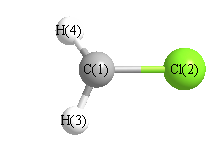Jump to
S1C2
Energy calculated at CCSD/aug-cc-pVDZ
| | hartrees |
|---|
| Energy at 0K | -498.791111 |
| Energy at 298.15K | |
| HF Energy | -498.490437 |
| Nuclear repulsion energy | 44.848765 |
The energy at 298.15K was derived from the energy at 0K
and an integrated heat capacity that used the calculated vibrational frequencies.
Vibrational Frequencies calculated at CCSD/aug-cc-pVDZ
| Mode Number |
Symmetry |
Frequency
(cm-1) |
Scaled Frequency
(cm-1) |
IR Intensities
(km mol-1) |
Raman Act
(Å4/u) |
Dep P |
Dep U |
|---|
| 1 |
A' |
3186 |
3069 |
7.96 |
|
|
|
| 2 |
A' |
1423 |
1371 |
14.73 |
|
|
|
| 3 |
A' |
841 |
810 |
33.22 |
|
|
|
| 4 |
A' |
219 |
211 |
60.19 |
|
|
|
| 5 |
A" |
3340 |
3217 |
0.00 |
|
|
|
| 6 |
A" |
996 |
960 |
0.00 |
|
|
|
Unscaled Zero Point Vibrational Energy (zpe) 5002.3 cm
-1
Scaled (by 0.9634) Zero Point Vibrational Energy (zpe) 4819.2 cm
-1
See section
III.C.1 List or set vibrational scaling factors
to change the scale factors used here.
See section
III.C.2
Calculate a vibrational scaling factor for a given set of molecules
to determine the least squares best scaling factor.
Geometric Data calculated at CCSD/aug-cc-pVDZ
Point Group is Cs
Cartesians (Å)
| Atom |
x (Å) |
y (Å) |
z (Å) |
|---|
| C1 |
-0.008 |
1.132 |
0.000 |
| Cl2 |
-0.008 |
-0.591 |
0.000 |
| H3 |
0.092 |
1.631 |
0.963 |
| H4 |
0.092 |
1.631 |
-0.963 |
Atom - Atom Distances (Å)
| |
C1 |
Cl2 |
H3 |
H4 |
| C1 | | 1.7233 | 1.0893 | 1.0893 |
Cl2 | 1.7233 | | 2.4238 | 2.4238 | H3 | 1.0893 | 2.4238 | | 1.9266 | H4 | 1.0893 | 2.4238 | 1.9266 | |
 More geometry information
More geometry information
Calculated Bond Angles
| atom1 |
atom2 |
atom3 |
angle |
|
atom1 |
atom2 |
atom3 |
angle |
| Br2 |
C1 |
H3 |
117.244 |
|
Br2 |
C1 |
H4 |
117.244 |
| H3 |
C1 |
H4 |
124.340 |
|
Electronic energy levels
Charges, Dipole, Quadrupole and Polarizability
Jump to
S1C1
Energy calculated at CCSD/aug-cc-pVDZ
| | hartrees |
|---|
| Energy at 0K | -498.791098 |
| Energy at 298.15K | |
| HF Energy | -498.490325 |
| Nuclear repulsion energy | 44.865589 |
The energy at 298.15K was derived from the energy at 0K
and an integrated heat capacity that used the calculated vibrational frequencies.
Vibrational Frequencies calculated at CCSD/aug-cc-pVDZ
| Mode Number |
Symmetry |
Frequency
(cm-1) |
Scaled Frequency
(cm-1) |
IR Intensities
(km mol-1) |
Raman Act
(Å4/u) |
Dep P |
Dep U |
|---|
| 1 |
A1 |
3190 |
3073 |
7.36 |
|
|
|
| 2 |
A1 |
1425 |
1372 |
15.19 |
|
|
|
| 3 |
A1 |
843 |
812 |
32.35 |
|
|
|
| 4 |
B1 |
153i |
147i |
65.05 |
|
|
|
| 5 |
B2 |
3346 |
3223 |
0.04 |
|
|
|
| 6 |
B2 |
993 |
957 |
0.00 |
|
|
|
Unscaled Zero Point Vibrational Energy (zpe) 4821.8 cm
-1
Scaled (by 0.9634) Zero Point Vibrational Energy (zpe) 4645.3 cm
-1
See section
III.C.1 List or set vibrational scaling factors
to change the scale factors used here.
See section
III.C.2
Calculate a vibrational scaling factor for a given set of molecules
to determine the least squares best scaling factor.
Geometric Data calculated at CCSD/aug-cc-pVDZ
Point Group is C2v
Cartesians (Å)
| Atom |
x (Å) |
y (Å) |
z (Å) |
|---|
| C1 |
0.000 |
0.000 |
-1.131 |
| Cl2 |
0.000 |
0.000 |
0.591 |
| H3 |
0.000 |
0.965 |
-1.635 |
| H4 |
0.000 |
-0.965 |
-1.635 |
Atom - Atom Distances (Å)
| |
C1 |
Cl2 |
H3 |
H4 |
| C1 | | 1.7220 | 1.0889 | 1.0889 |
Cl2 | 1.7220 | | 2.4266 | 2.4266 | H3 | 1.0889 | 2.4266 | | 1.9299 | H4 | 1.0889 | 2.4266 | 1.9299 | |
 More geometry information
More geometry information
Calculated Bond Angles
| atom1 |
atom2 |
atom3 |
angle |
|
atom1 |
atom2 |
atom3 |
angle |
| Br2 |
C1 |
H3 |
117.602 |
|
Br2 |
C1 |
H4 |
117.602 |
| H3 |
C1 |
H4 |
124.796 |
|
Electronic energy levels
Charges, Dipole, Quadrupole and Polarizability
